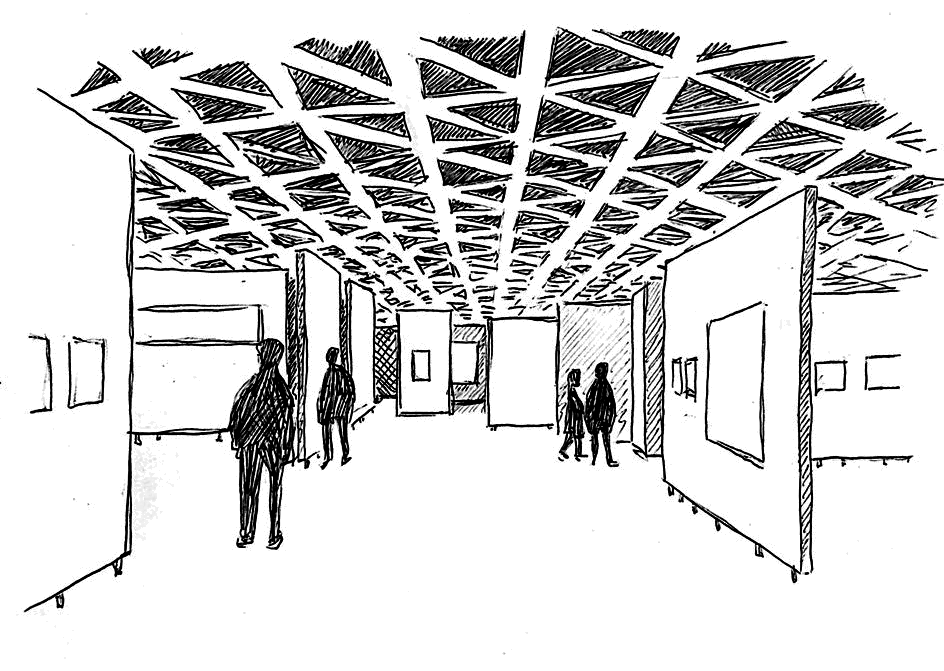
Sunday morning, pouring rain after a luxurious brunch of quiche and black tea in the dining hall, I set off as I always do towards the Yale University Art Gallery. It’s a tradition my best friend and I have continued since we started at Yale. Each week, we tackle a single gallery in the YUAG. We’ve done Indo-pacific, modern art, and temporary exhibitions. We’ve also been to the Beinecke Rare Book and Manuscript Library, several floors of the Yale Center for British Art, and even a trip to the School of Architecture. But we always come back to the YUAG. It pains me when I hear that some of my friends have never been. I think it’s one of the greatest resources at Yale. My Russian art sections are held here. I came here for the Chubb awards celebrating Faith Ringgold. But nothing beats my Sunday mornings.
Today we walk in and dropped our umbrellas in the lobby. I ascend the giant elevator equipped for moving pieces of art. I walk through the modern gallery. I pause momentarily in front of a favorite piece by Helen Frankenthaler. I smile at an El Anatsui. I giggle with a costumed Nick Cave sculpture. They feel like old friends. I move past the Sol le Witt wall drawings. It pains me that they’re going to paint over them soon. At least the geometric black and white piece with the embedded instructions is permanent. I pass through decorative arts. I come to 20th century American. I often frown at American art — I think other cultures did it better and earlier. But this is a gorgeous gallery.
There is a corner full of pieces by Charles Demeuth. Posters he printed celebrating other artists. Why would he do that? For their shows? I like the clean lines and clear cut words. He takes the motifs of these artists, and rearranged them in his own style. I examine the Hopper paintings. They’re beautiful — but so sad. Isolated figures stare into space. He’s most famous for “Night Hawk”, a hallmark of 1950s isolationism. Women in primary color dresses, men in suits — it should be a joyous scene. But the strong lines, the intrusion of the exterior onto the interior give an eerie sense to the paintings. The window of a cafe brings the street into the room. Rolling hills in a different piece seem to be inside the bare motel room.
I like American precisionism. I like what it says about the one period. Everything in its place: industrialism, factory lines. I like its perverted sadness. Charles Scheeler, a big name in the movement, showcases the industrial world. He pulls from Cubism — though Scheeler depicts mostly buildings, I’m reminded of Picasso’s famous Cubist work “Les Demoiselles d’Avignon.” Scheeler’s work is more about the geometry than the buildings. Like the Hoppers, the landscape blends into the buildings in sheer forms.
Next to the chaos of a Frank Stella painting, I think to myself: ‘I had my first kiss at a Frank Stella exhibit.’ The work seems to have more in common with Kandinsky and Scheeler — how could they have painted at the same time? Yet I can see the connection. A focus on lines and geometry. But whereas the other artists use this to clarify their work, Stella uses it to confuse his.
Then on to my favorite artist in the room — Florine Stettheimer. For so long she was not collected by museums. I think about a New York Times article I recently read, which called her, a “great New York painter, Jazz Age saloniste and cult figure.” I like to think that if or when I acquire the means, I’ll collect her work first. (And Agnes Martin, another underappreciated female painter.) I love Stettheimer’s work. It’s pink and fluffy like a piece of cake. Maybe that’s why it wasn’t taken seriously. The figures seem stacked on top of each other — she doesn’t seem to care about perspective. In one, a reclining nude portrait hangs in the back. Men mill bout, none of them addressing the elephant in the room. Bright spots of yellow speckle the piece, along with women in 1920s-style cocktail dresses. I like the woman in the purple turban and black beads. Long stocking legs stick out beneath a drop-waist dress. Men appear to ponder. ‘The gallery is so quiet today,’ I think. Two figures look at a painting within the painting. Anything to avoid looking at the reclining nude.
Then I come to a piece by the same artist entitled “Carl van Vechten”. The central figure looks just like fashion designer Karl Lagerfeld: piercing blue eyes, smooth gray hair, sunglasses indoors. They even have the same name. There’s even a cat in the foreground that could be Choupette, Lagerfeld’s famed cat, with its own book and makeup line. Coincidence? Collusion?
I exit past the giant portrait of George Washington. My grandfather loves that piece; I wonder if he would like the subversive Stettheimers. I have to go back over the bridge to get out. The architecture of this place has always confused me. I walk past the Gallery’s most famous piece, “Night Cafe”. I recently read about the controversy surrounding the acquisition of the painting, and its lasting effect on Russian art entering the United States. There are so many stories to be told in this museum.
Back out into the rain. My refuge is over.
Claire Kalikman | claire.kalikman@yale.edu







